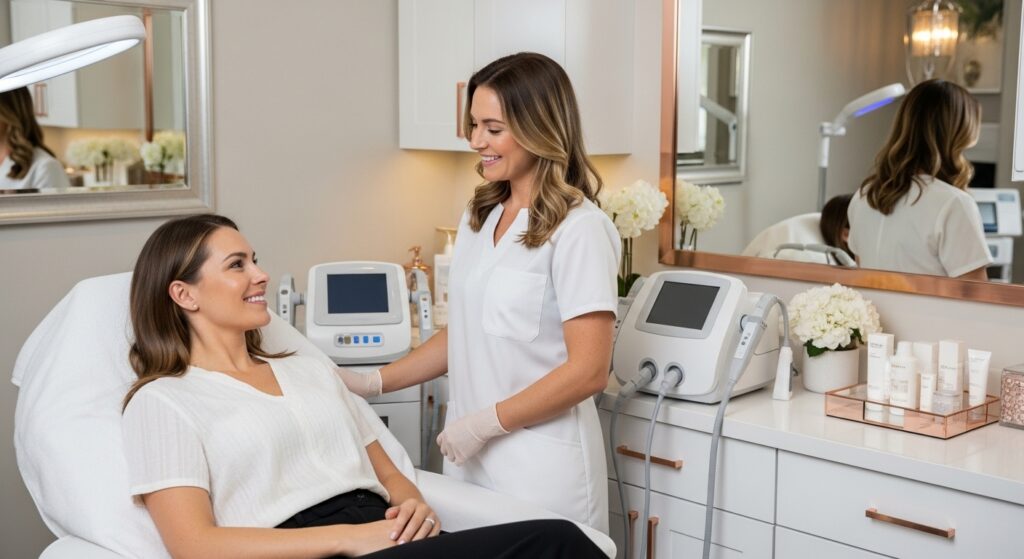Patient referral programs can be incredibly lucrative for aesthetic practices, bringing new patients through the door, creating brand awareness, and increasing revenue. However, the path to implementing these programs is fraught with regulatory complexities that require careful navigation.
Understanding the Legal Landscape
The Federal Anti-Kickback Statute serves as the primary regulatory framework governing patient referral programs. This law prohibits offering anything of value—whether cash, gift cards, or discounts—in exchange for referrals of services covered by healthcare programs.
"Most US states have some form of kickback laws related to healthcare services, so each state is a little bit different, but all of them have some form of a kickback law in place particularly to prevent conflict of interest or unethical practices." - MJ
For many aesthetic practices that offer both traditional spa treatments and regulated medical services like Botox or laser treatments, this creates a complex situation. The rules governing medical services, including anti-kickback laws, will apply to those specific services, while spa treatments may have more flexibility.

The Medical vs. Non-Medical Distinction
The key to compliance lies in understanding the distinction between medical and non-medical services. Medical services such as Botox, HRT, laser treatments, and medical-grade skincare treatments like chemical peels cannot be included in referral reward programs. However, non-medical services like traditional facials generally don’t fall under these restrictions.
"Since spa services generally don't involve a medical treatment, the rules governing that healthcare referral such as anti-kickback statute does not generally apply for those." - MJ
Best Practices for Compliant Referral Programs
1. Clear Documentation and Transparency
Any referral program agreement should be clearly documented and comply with state and federal advertising laws. Terms and conditions must be transparent and not misleading in any way.
2. Restrict Medical Services
Medical services cannot be included in referral reward programs. This includes injectables, laser treatments, and medical-grade skincare procedures.
3. Understand Local Business Laws
Consider tax implications and other local business regulations. Large gift cards, for example, might have tax consequences that need to be addressed.
Compliant Referral Program Examples
Retail Rewards
For each successful referral (someone who books an appointment and pays for a service), the referring client receives a complimentary skincare product. This structure works because the reward is non-cash, not healthcare-related, and represents a modest, reasonable value.
Spa Service Rewards
Offering a free, low-cost consumable spa service like a 30-minute express signature facial can be compliant. The key is avoiding high-cost services like HydraFacials, which can have consumables costs of around $90 per service.
Loyalty Points System
“By far the most successful version of this that I’m seeing are those loyalty points because you can build in ways to earn loyalty points in addition to just referring new patients.” – Katlin
Transitioning Existing Programs
For practices with existing non-compliant programs, the transition requires careful communication with patients. When patients ask about using rewards for medical services, staff should be prepared with transparent explanations:
“I see you have 500 loyalty points here, here is how you could use those funds—you could do a HydraFacial,” and then list approved options. When patients inquire about restricted services, use it as an opportunity to educate and potentially upsell with complimentary consultations.
The Power of Patient Education
"Patient education is so vital especially when things are so gray... telling patients no I'm sure you guys experience this every day that builds so much authority." - MJ
When patients understand that restrictions exist for their protection and the practice’s compliance, they’re more likely to appreciate the transparency and work within the approved framework.

Building Successful Programs
The most successful referral programs create multiple pathways for earning rewards while maintaining compliance. Consider structuring loyalty points to reward:
- Successful referrals (500 points)
- Regular service visits (100 points per service)
- Retail purchases (100 points per purchase)
This multi-faceted approach keeps patients engaged while allowing practices to cross-sell services and build long-term loyalty.
Key Takeaways
Patient referral programs remain a powerful tool for aesthetic practices when implemented correctly. The key is understanding the regulatory landscape, maintaining clear distinctions between medical and non-medical services, and prioritizing transparency with patients.
Remember that this guidance is not legal advice, and it’s crucial to consult with a healthcare attorney to review any referral program before implementation. Each state has specific regulations, and professional legal guidance ensures full compliance while maximizing the benefits of these valuable marketing tools.
By following these guidelines, aesthetic practices can create referral programs that drive growth while maintaining full regulatory compliance—a win-win for both business success and professional integrity.


